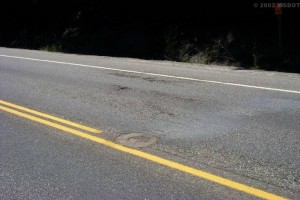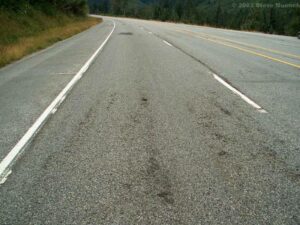Raveling
The progressive disintegration of an HMA layer from the surface downward as a result of the dislodgement of aggregate particles.
Raveling possibly resulting from segregation, temperature differentials or inadequate compaction.

Raveling that is likely the result of segregation and/or construction-related temperature differentials.
Problem
Loose debris on the pavement, roughness, water collecting in the raveled locations resulting in vehicle hydroplaning, loss of skid resistance and accelerated pavement wear.
Possible Causes
- Loss of bond between aggregate particles and the asphalt binder as a result of:
- A dust coating on the aggregate particles that forces the asphalt binder to bond with the dust rather than the aggregate.
- Aggregate segregation. If fine particles are missing from the aggregate matrix, then the asphalt binder is only able to bind the remaining coarse particles at their relatively few contact points.
- Inadequate compaction during construction. High density is required to develop sufficient cohesion within the HMA.
- Mechanical dislodging by certain types of traffic (studded tires, snowplow blades or tracked vehicles).
Repair
A raveled pavement should be investigated to determine the root cause of failure. Adding a fog seal to a pavement with slight raveling (before it has progressed) is something that could be done to delay a rehabilitation. If the raveled pavement isn’t holding moisture, a chip seal could be placed on top to get some additional years of life out of the pavement. Of course, if the raveling has progressed, the best practice would then be to remove the pavement by milling and replace.
Surface Distresses



